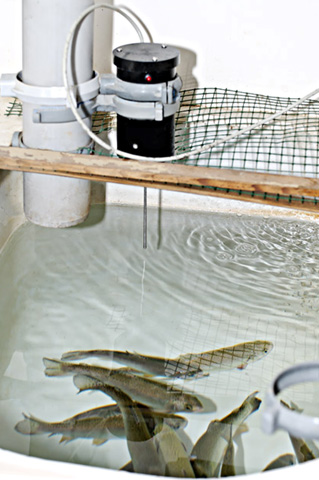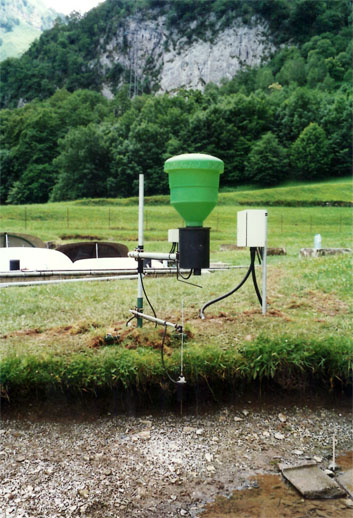Since 1988, IMETRONIC company has been designing and manufacturing automatic apparatus for behavioral essays for research in neurobiology and pharmacology. Imetronic has got a good knowledge of animal behavior and of automation. We collaborated with a research team (INRA: T. Boujard) to validate the self-feeder for fish.
IMETRONIC self-feeder allows:
1 – easy-to-set protocols for feeding (window time /number of doses / threshold of the number of demands / food regulation according to rationing theory …)
2 – a real-time graphical monitoring of all basins
3 – automatic recording of feeding behavior data
4 – a good command of food unit doses (0.1g-50g)
5 – monitoring the development of biomass.
A self-feeder consists of a sensor and a distributor that are connected to a computer via an electronic bus. The unit is controlled by a software that can manage up to 128 basins.
Sensor
The sensor consists of a waterproof PVC cylinder and a stainless steel rod. There are two expressions:
Dispenser
The dispenser includes a motor and a rotating cylinder. We manufacture three types of cylinders:
In 2015, using our experience on self-feeder for fish, we developed a new automatic feeder system for dry feed (<2mm) especially for zebrafish labs. 1 dose = around 0.4g.
We designed the system for a low cost.
Advantages
-easy to install -easy to clean -doses distributed easily editable (see permutation cylinder above) -accuracy (+ / – 1%) -low power consumption (150 mA per distributor) -competitive price level
Electronic Bus
Our electronic bus is guaranteed waterproof (IP 67).
It consists of a PC card, a cable connected to the card, electronic modules and a low supply voltage (24v =) The cable is held near the basins, the modules are easily clicking on the cables at the selected sites, each has got 4 inputs and 4 outputs, the sensor is connected to an input, and the dispenser to an output. Example: an electronic module can mange 4 basins, with a sensor and a dispenser per basin.
BENEFITS
The interests of the bus: it can manage up to 128 basins, it is possible to add other types of sensors and actuators (sensor-level, meter, solenoid ..) as an evolving system (4 basins .. . 128 basins), bus length: 200 meters.
The software runnig on Windows allows creating a breeding (number of basins, location, number of self-feeders per basin…), feeding protocol (number of demands required for distribution, periods of inhibition, regulation, correction…) and controlling the feeding behavior of your breeding subjected to different protocols.
-each basin is independent (on / off protocol), -a friendly editor allows creating a library of protocols, -a software module can simulate these protocols (fast time, simulation of demands…) – taken into account at all times of conversion ratios, rates of rationing, weighing … -monitoring the development of biomass.
MORE DETAILS
The software consists of three types of screens:
1) A general screen called “breeding” which presents an overview of livestock.
2) Another screen in the form of graphics presents in real time the evolution of breeding.
3) Then a third screen that displays data and graphics from a basin selected.
References